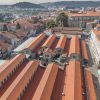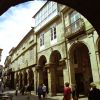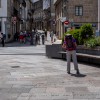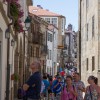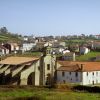- Accede I
- Regístrate I
- carrito
14. Mercado de Abastos
14. Mercado de Abastos
Galería de imágenes

En cualquier ciudad, el mercado es un ejemplo de la vida cotidiana de sus gentes. En Santiago, la visita al mercado tiene un triple interés: cultural, gastronómico y arquitectónico. En él se siguen manteniendo las formas de comercio tradicional, de proximidad y el trato directo, lo que constituye uno de sus principales encantos.
En la Edad Media, los vendedores ocupaban varias plazas de la ciudad: las de Platerías, Azabachería y principalmente la de Cervantes. A finales del siglo XIX se decidió concentrar esta intensa actividad en las antiguas huertas del Conde de Altamira. Así surgió este mercado de abastos, cuyas naves fueron levantadas a fines de los años 30 por Joaquín Vaquero Palacios. Si nos adentramos en su interior, descubriremos cómo su arquitectura recoge la tradición de la construcción gallega, con el granito, las formas rotundas y un toque de sabor aldeano.
El mercado abre todos los días excepto el domingo. Junto a los puestos fijos de las casetas, acuden a él las ‘paisanas’, nombre que reciben las agricultoras que venden los productos recién salidos de sus propias huertas y cultivados con sus propias manos. Cada una de ellas tiene su lugar asignado, y son las encargadas de colorear los pasillos con sus frutas y verduras.
La nave más llamativa es probablemente la dedicada a pescados y mariscos, que llegan todos los días de las rías gallegas, el Atlántico y el Cantábrico. En otras naves, encontramos la famosa ternera gallega, el cerdo, que protagoniza la temporada a partir de su matanza en noviembre, aves y conejos. Patatas, pan, frutas y verduras, quesos, y también flores, semillas y plantas, completan este bodegón, que nos permite profundizar en la cultura gastronómica de Galicia.
Todos aquellos que así lo deseen, podrán complementar esta experiencia degustando alguno de los productos que ofrecen diferentes locales o simplemente asistiendo a diversos eventos en su renovada aula gastronómica.














